Articles
- Page Path
- HOME > J Korean Acad Nurs > Volume 46(1); 2016 > Article
-
Original Article
- Reliability and Validity of the Korean Version of the Perinatal Post-Traumatic Stress Disorder Questionnaire
- Yu Kyung Park, Hyeon Ok Ju, Hunjoo Na
-
Journal of Korean Academy of Nursing 2016;46(1):29-38.
DOI: https://doi.org/10.4040/jkan.2016.46.1.29
Published online: February 29, 2016
1Choonhae College of Health Science, Ulsan, Korea.
2Department of Nursing, Dong-A University, Busan, Korea.
- Address reprint requests to: Ju, Hyeon Ok. Department of Nursing, Dong-A University, 32 Daesin Gongwon-ro, Seo-gu, Busan 49201, Korea. Tel: +82-51-240-2689, Fax: +82-51-240-2920, enfanju@dau.ac.kr
© 2016 Korean Society of Nursing Science
This is an Open Access article distributed under the terms of the Creative Commons Attribution NoDerivs License. (http://creativecommons.org/licenses/by-nd/4.0/) If the original work is properly cited and retained without any modification or reproduction, it can be used and re-distributed in any format and medium.
Abstract
-
Purpose
- The Perinatal Post-Traumatic Stress Disorder Questionnaire (PPQ) was designed to measure post-traumatic symptoms related to childbirth and symptoms during postnatal period. The purpose of this study was to develop a translated Korean version of the PPQ and to evaluate reliability and validity of the Korean PPQ.
-
Methods
- Participants were 196 mothers at one to 18 months after giving childbirth and data were collected through e-mails. The PPQ was translated into Korean using translation guideline from World Health Organization. For this study Cronbach's alpha and split-half reliability were used to evaluate the reliability of the PPQ. Exploratory Factor Analysis (EFA), Confirmatory Factor Analysis (CFA), and known-group validity were conducted to examine construct validity. Correlations of the PPQ with Impact of Event Scale (IES), Beck Depression Inventory II (BDI-II), and Beck Anxiety Inventory (BAI) were used to test a criterion validity of the PPQ.
-
Results
- Cronbach's alpha and Spearman-Brown split-half correlation coefficient were 0.91 and 0.77, respectively. EFA identified a 3-factor solution including arousal, avoidance, and intrusion factors and CFA revealed the strongest support for the 3-factor model. The correlations of the PPQ with IES, BDI-II, and BAI were .99, .60, and .72, respectively, pointing to criterion validity of a high level.
-
Conclusion
- The Korean version PPQ is a useful tool for screening and assessing mothers' experiencing emotional distress related to child birth and during the postnatal period. The PPQ also reflects Post Traumatic Stress Disorder's diagnostic standards well.
This study was supported by research funds from Dong-A University.
The authors declared no conflict of interest.
- 1. American Psychiatric Association. Diagnostic and statistical manual of mental disorders, third edition-revised. 3rd ed. Washington, DC: Author; 1987.
- 2. American Psychiatric Association. Diagnostic and statistical manual of mental disorders, DSM-IV. 4th ed. Washington, DC: Author; 1994.
- 3. Leeds L, Hargreavesa I. The psychological consequences of childbirth. J Reprod Infant Psychol. 2008;26(2):108–122. Article
- 4. Olde E, van der Hart O, Kleber R, van Son M. Posttraumatic stress following childbirth: A review. Clin Psychol Rev. 2006;26(1):1–16. ArticlePubMed
- 5. White T, Matthey S, Boyd K, Barnett B. Postnatal depression and post–traumatic stress after childbirth: Prevalence, course and cooccurrence. J Reprod Infant Psychol. 2006;24(2):107–120. Article
- 6. Alcorn KL, O'Donovan A, Patrick JC, Creedy D, Devilly GJ. A prospective longitudinal study of the prevalence of post-traumatic stress disorder resulting from childbirth events. Psychol Med. 2010;40(11):1849–1859. ArticlePubMed
- 7. DeMier RL, Hynan MT, Harris HB, Manniello RL. Perinatal stressors as predictors of symptoms of posttraumatic stress in mothers of infants at high risk. J Perinatol. 1996;16(4):276–280.PubMed
- 8. Ayers S, Pickering AD. Do women get posttraumatic stress disorder as a result of childbirth? A prospective study of incidence. Birth. 2001;28(2):111–118.ArticlePubMedPDF
- 9. Callahan JL, Hynan MT. Identifying mothers at risk for postnatal emotional distress: Further evidence for the validity of the perinatal posttraumatic stress disorder questionnaire. J Perinatol. 2002;22(6):448–454. ArticlePubMedPDF
- 10. Pizur-Barnekow K, Erickson S. Perinatal posttraumatic stress disorder: Implications for occupational therapy in early intervention practice. Occup Ther Ment Health. 2011;27(2):126–139. Article
- 11. Pierrehumbert B, Borghini A, Forcada-Guex M, Jaunin L, Müller-Nix C, Ansermet F. French validation of the "perinatal PTSD questionnaire" assessing parent's posttraumatic stress reactions following the birth of a high risk infant. Ann Med Psychol (Paris). 2004;162(9):711–721.
- 12. Kim GS. Analysis structural equation modeling. Seoul: Hannarae Publishing Co.; 2013.
- 13. Moon SB. Basic concepts and applications of structural equation modeling: With AMOS 19.0. Seoul: Hakjisa Corp; 2009.
- 14. Callahan JL, Borja SE, Hynan MT. Modification of the perinatal PTSD questionnaire to enhance clinical utility. J Perinatol. 2006;26(9):533–539. ArticlePubMedPDF
- 15. Quinnell FA, Hynan MT. Convergent and discriminant validity of the perinatal PTSD questionnaire (PPQ): A preliminary study. J Trauma Stress. 1999;12(1):193–199. ArticlePubMed
- 16. Horowitz M, Wilner N, Alvarez W. Impact of event scale: A measure of subjective stress. Psychosom Med. 1979;41(3):209–218.ArticlePubMed
- 17. Weiss DS, Marmar CR. The impact of event scale—revised. In: Wilson JP, Keane TM, editors. Assessing psychological trauma and PTSD. New York, NY: Guilford; 1997. p. 399–411.
- 18. Eun HJ, Kwon TW, Lee SM, Kim TH, Choi MR, Cho SJ. A study on reliability and validity of the Korean version of impact of event scale-revised. J Korean Neuropsychiatr Assoc. 2005;44(3):303–310.
- 19. Beck AT, Steer RA, Brown GK. Manual for the Beck depression inventory-II. San Antonio, TX: Psychological Corporation; 1996.
- 20. Kim MS, Lee IS, Lee CS. The validation study I of Korean BDI-II: In female university students sample. Korean J Clin Psychol. 2007;26(4):997–1014.
- 21. Kwon SM. Differential roles of dysfunctional attitudes and automatic thoughts in depression: An integrated cognitive model of depression [dissertation]. Brisbane, AU, The University of Queensland. 1993.
- 22. World Health Organization. Process of translation and adaptation of instruments [Internet]. Geneva, CH, Author. 2015;cited 2015 March 13. http://www.who.int/substance_abuse/research_tools/translation/en/
- 23. Kang H. A guide on the use of factor analysis in the assessment of construct validity. J Korean Acad Nurs. 2013;43(5):587–594. ArticlePubMed
- 24. American Psychiatric Association. Diagnostic and statistical manual of mental disorders, fifth edition (DSM-5). 5th ed. Washington, DC: Author; 2013.
- 25. Harrington D. Confirmatory factor analysis. New York, NY: Oxford University Press; 2009.
- 26. Hong S. The criteria for selecting appropriate fit indices in structural equation modeling and their rationales. Korean J Clin Psychol. 2000;19(1):161–177.
- 27. DeVellis RF. Scale development: Theory and applications. 3rd ed. Thousand Oaks, CA: Sage Publications; 2012.
- 28. Seong TJ. Validity and reliability. Seoul: Hakjisa Corp; 2010.
- 29. Kessler RC, Sonnega A, Bromet E, Hughes M, Nelson CB. Posttraumatic stress disorder in the national comorbidity survey. Arch Gen Psychiatry. 1995;52(12):1048–1060. ArticlePubMed
- 30. Lee K, Shin S. Validity of instrument development research in Korean nursing research. J Korean Acad Nurs. 2013;43(6):697–703. ArticlePubMed
REFERENCES
Appendix
Korean Version of the Perinatal Post-Traumatic Stress Disorder Questionnaire [Korean PPQ])
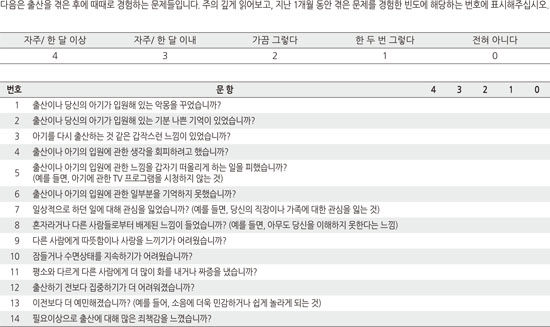
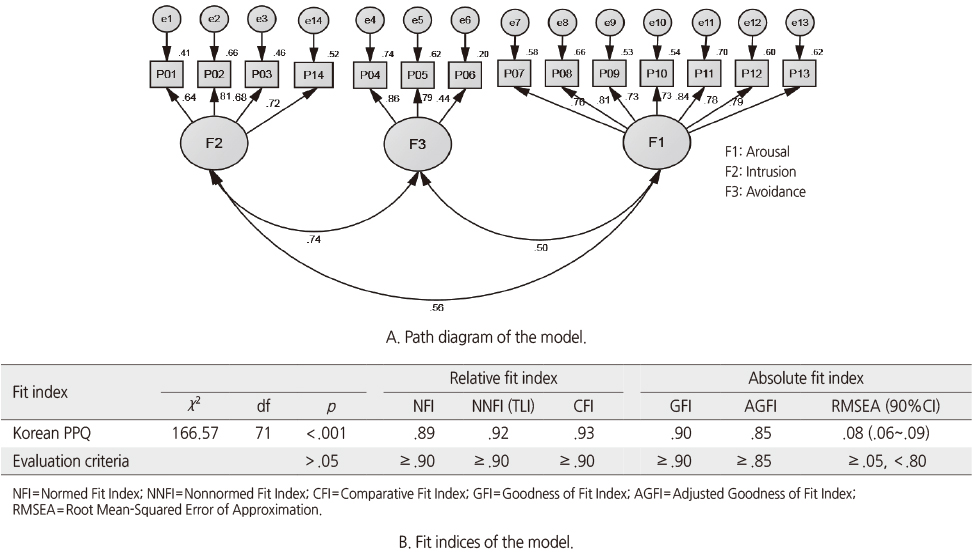
Figure & Data
REFERENCES
Citations

- Association between blood pressure trajectories during pregnancy and childbirth-related post-traumatic stress disorder symptoms
Shu Wang, Linli Zou, Xiaolu Lai, Jingfen Chen, Daniel Krewski, Shi Wu Wen, Ri-hua Xie
Journal of Psychiatric Research.2025; 189: 455. CrossRef - Prenatal psychosocial factors and postpartum post-traumatic stress disorder in low-risk postnatal women: a longitudinal study
Jung Hee Yeo, So Yeon Park
Journal of Korean Academy of Nursing.2025; 55(3): 353. CrossRef - Validation of the Polish PPQ-II: sociodemographic and clinical correlates of perinatal PTSD
Anna Weronika Szablewska, Lucyna Wójcicka, Arkadiusz Prajzner, Agata Zdun-Ryżewska, Julia Burdecka, Dagmara Klasa-Mazurkiewicz
Frontiers in Psychology.2025;[Epub] CrossRef - A nomogram for predicting postpartum post-traumatic stress disorder: a prospective cohort study
Xiaoting Wang, Jiaxin Ren, Linping Kang, Jing Lu, Hongxia Wang
BMC Psychiatry.2024;[Epub] CrossRef - Risk factors for postpartum posttraumatic stress disorder after emergency admission
Fengxia Du, Jun Zha, Yan Li, Lichao Fang, Shuyu Xia, Youjia Yu
World Journal of Emergency Medicine.2024; 15(2): 121. CrossRef - Effects of Posttraumatic Stress Disorder and Depression on Paternal Attachment to High-Risk Infants
Yu Jin Lee, Hyeon Ok Ju
Journal of The Korean Society of Maternal and Child Health.2024; 28(1): 12. CrossRef - Psychometric properties of the European Portuguese version of the modified perinatal PTSD questionnaire (PPQ-II)
Stephanie Alves, Mariana Claro, Ana Beato
Current Psychology.2024; 43(13): 11865. CrossRef - Association of postpartum depression with postpartum posttraumatic stress disorder in Korean mothers: a longitudinal survey
Hyunjin Cho, Minseon Koh, Hyeji Yoo, Sukhee Ahn
Korean Journal of Women Health Nursing.2022; 28(1): 46. CrossRef - Validation of perinatal post-traumatic stress disorder questionnaire for Spanish women during the postpartum period
Antonio Hernández-Martínez, Sergio Martínez-Vázquez, Julian Rodríguez-Almagro, Khalid Saeed Khan, Miguel Delgado-Rodríguez, Juan Miguel Martínez-Galiano
Scientific Reports.2021;[Epub] CrossRef - Mothers’ Perceptions of Quality of Family-Centered Care and Environmental Stressors in Neonatal Intensive Care Units: Predictors of and Relationships with Psycho-emotional Outcomes and Postpartum Attachment
Ah Rim Kim, Young Ran Tak, Yong Soon Shin, E. Hwa Yun, Hyun-Kyung Park, Hyun Ju Lee
Maternal and Child Health Journal.2020; 24(5): 601. CrossRef - Validating the Psychometric Characteristics of the Perinatal Posttraumatic Stress Disorder Questionnaire (PPQ) in a Chinese Context
Di Zhang, Jun Zhang, Quan Gan, Qiaoling Wang, Nian Fan, Rong Zhang, Yayun Song
Archives of Psychiatric Nursing.2018; 32(1): 57. CrossRef
- Figure
- We recommend
- Related articles
-
- Reliability and validity of the Korean version of the Nurses Professional Values Scale-3 for nursing students: a methodological study
- The Reliability and Validity of the Korean Version of the 5C Psychological Antecedents of Vaccination Scale
- The Reliability and Validity of Korean Version of the Infertility Stigma Scale (K-ISS)

Figure. 1
Exploratory Factor Analysis of Korean PPQ
NFI=Normed Fit Index; NNFI=Nonnormed Fit Index; CFI=Comparative Fit Index; GFI=Goodness of Fit Index; AGFI=Adjusted Goodness of Fit Index; RMSEA=Root Mean-Squared Error of Approximation.
Convergent Validity and Discriminant Validity
AVE=Average variance extracted; CR=Construct reliability.
Comparison of Korean PPQ Scores between Fullterm and Preterm Group (N =196)
PPQ=Perinatal PTSD questionnaire.
Correlations of Korean PPQ, IES-K-R, BDI-II and BAI (N =196)
PPQ=Perinatal PTSD questionnaire; IES-K-R=Korean version of impact of event scale-revised; BDI=Beck depression inventory; BAI=Beck anxiety inventory.
NFI=Normed Fit Index; NNFI=Nonnormed Fit Index; CFI=Comparative Fit Index; GFI=Goodness of Fit Index; AGFI=Adjusted Goodness of Fit Index; RMSEA=Root Mean-Squared Error of Approximation.
AVE=Average variance extracted; CR=Construct reliability.
PPQ=Perinatal PTSD questionnaire.
PPQ=Perinatal PTSD questionnaire; IES-K-R=Korean version of impact of event scale-revised; BDI=Beck depression inventory; BAI=Beck anxiety inventory.
 KSNS
KSNS
 E-SUBMISSION
E-SUBMISSION
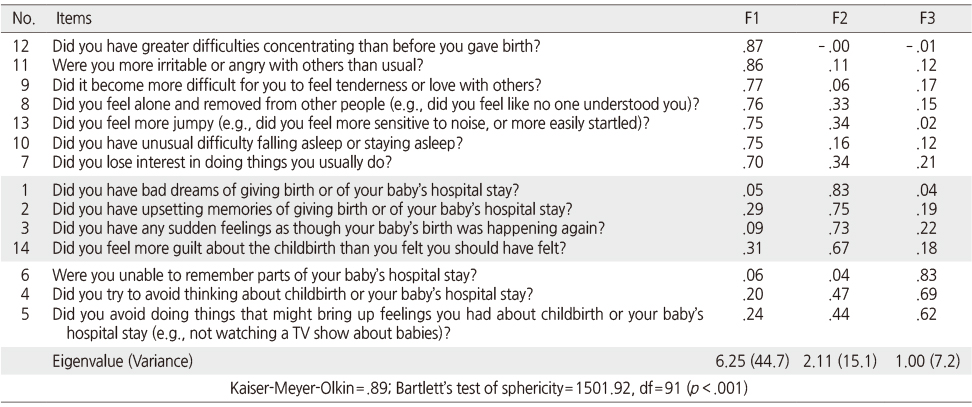
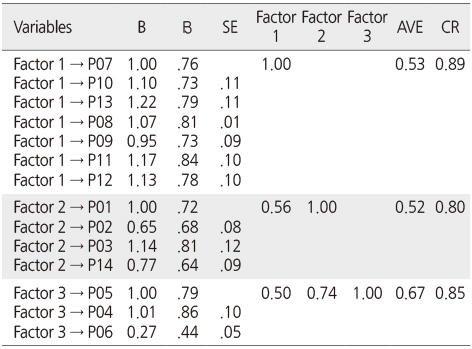
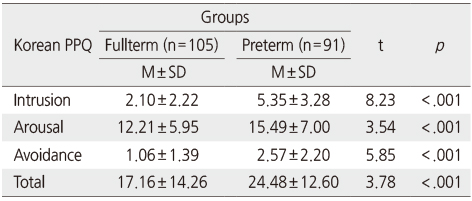
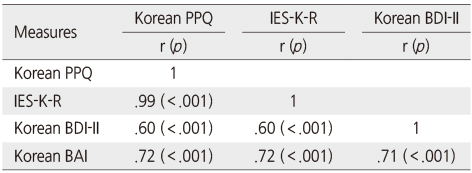
 Cite
Cite

